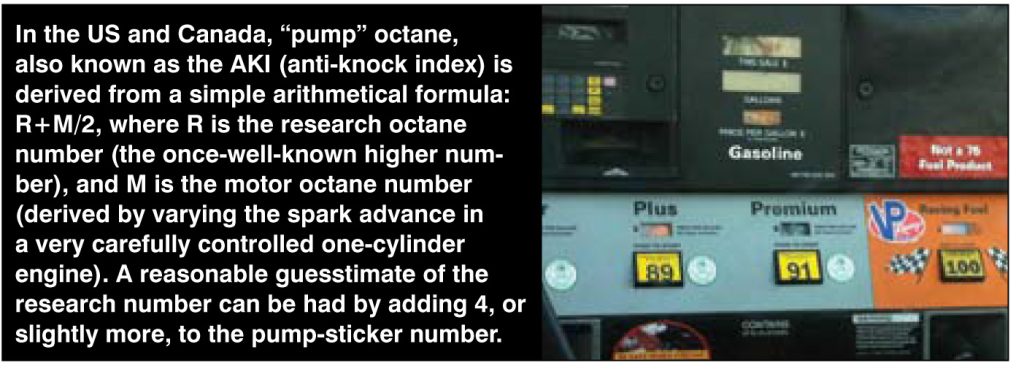Pumped Up
PUMPED UP
I can’t recall this ever being a topic, tech
or otherwise: when did the octane ratings
of gasoline change from MON to the AKI
(R+M/2 formula) in the U.S.? I understand
that the “R+M” rating gives up 5 points vs.
the MON rating (i.e. 105 octane ‘MON’ vs
95 octane ‘R+M’), but why the change?
Makes me believe that the coveted Sunoco
260 (Chevron ‘Custom Supreme’ on the
west coast) was really 95-100 AKI octane .
The change (from RON, not MON) was
required as part of the law that required
the yellow “pump octane” stickers, this
went into effect on April 1, 1979. On that
date, I clearly remember Sunoco 260
being posted at 97.5, within a year or so,
it was down to 96. When everything went
unleaded, Sunoco backed down to 94,
then 93 about a decade ago. Both of these
products are (were) branded as “Ultra”.
Incidentally, Sunoco no longer actually
“makes” (refines) gasoline.
The pessimist in me says the change
was made because of the typical government
“consensus” decision-making process.
My optimistic side, however, would
like to believe that the AKI more accurately
reflects real-world anti-knock performance.
The variation (offset) number that I’ve
always used for rough “in my head” calculations
is: Add 4 points to the pump
octane (AKI, “yellow sticker”) number to
come up with a reasonable approximation
of the now-seldom-used Research Octane
number (the “R” in the R+M/2 formula).
This formula can vary quite a bit however,
I have seen numbers as high as 6 bandied
about. BTW, you have your calculations
wrong, the motor (M) number is much
lower than either RON or R+M/2.
One thing I can say with some measure
of certainty: The AKI is almost always quite
a bit higher than the sticker claims. I know
that Chrysler has to pay big bucks for
“certified” (lab grade) 91 octane fuel for
calibration (dyno cell) use, almost all that’s
bought at retail is a lot higher. Having said
that, I will also say that a local chain in
my area has begun selling ethanol-free”
91, mostly aimed at small-engine use (93
is much more common in most of NYS), I
tried it in a few cars and it was Detonation
City! Still, it might pay to use “E0” fuel for
the last fill-up prior to winter storage, this
would go some way towards preventing
problems such as those encountered by
reader Russo (see p. 10).
One thing’s for certain: If the refiners
would increase the octane levels gener-

ally available, automakers could provide
both more power and better fuel economy.
Refiners counter that producing higher
octane uses more crude oil per gallon of
gasoline.

